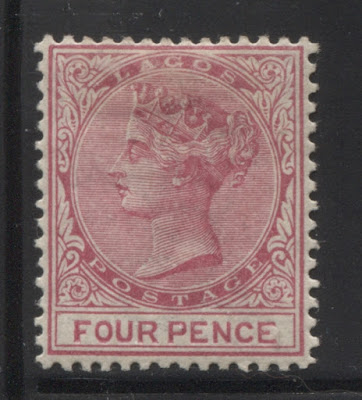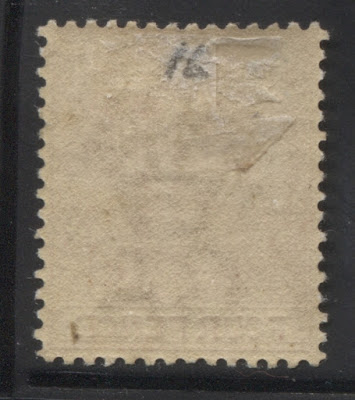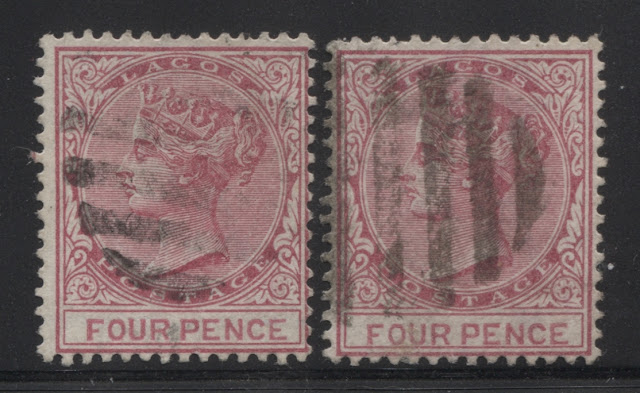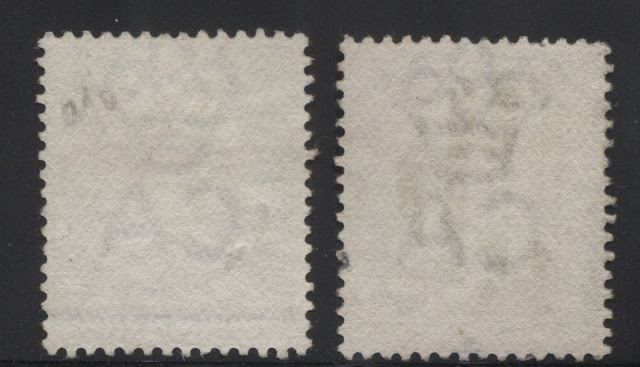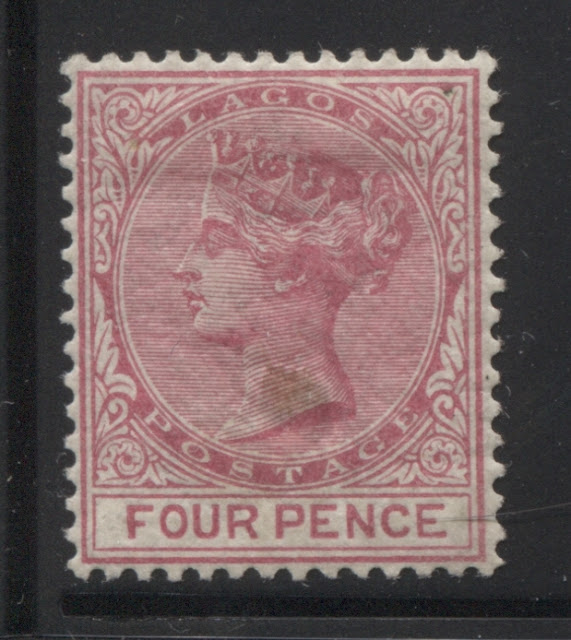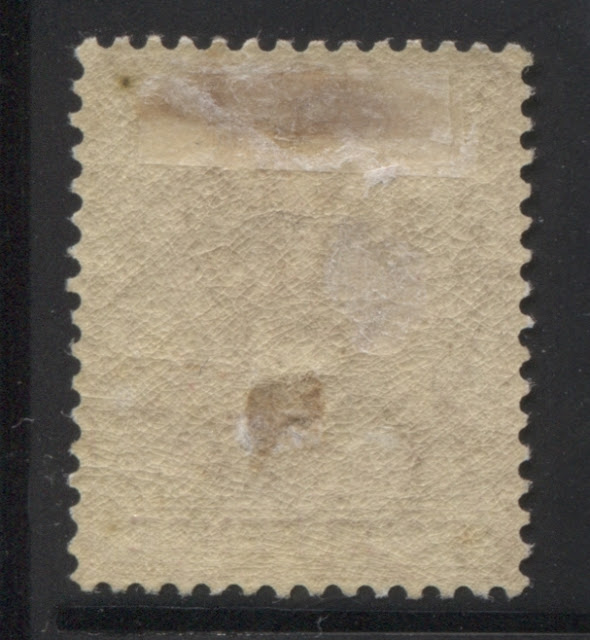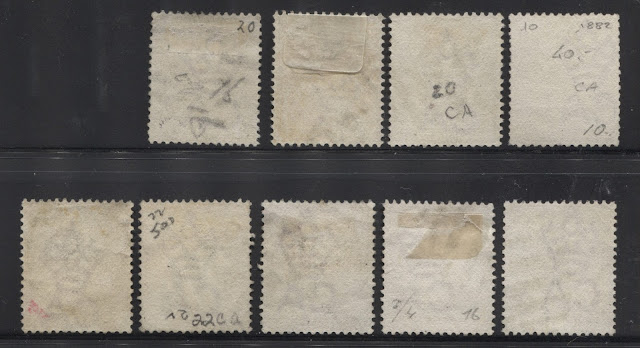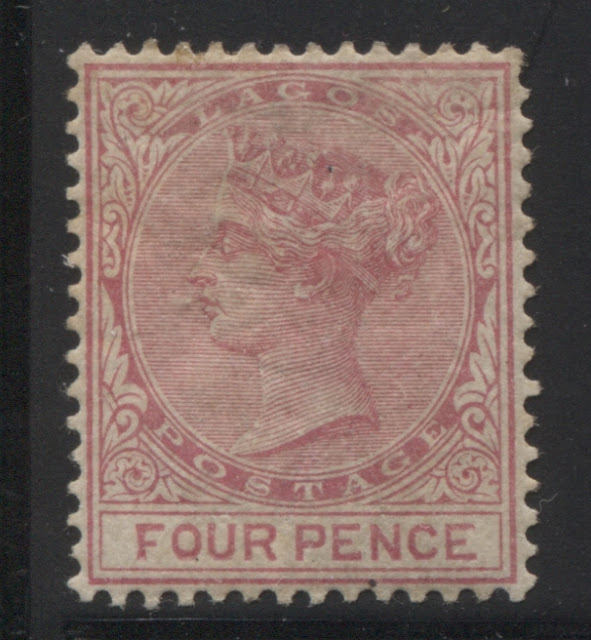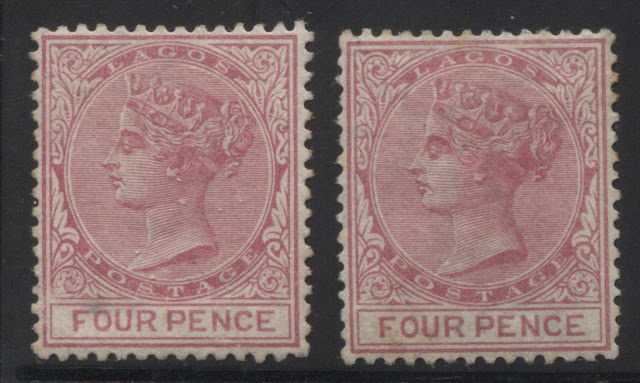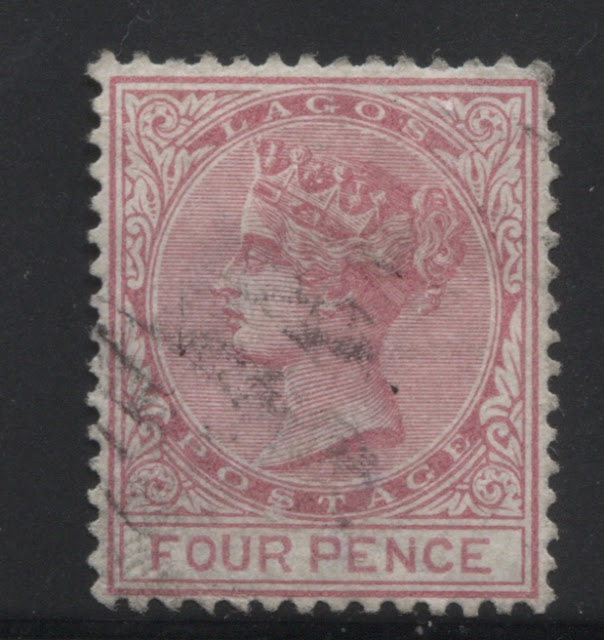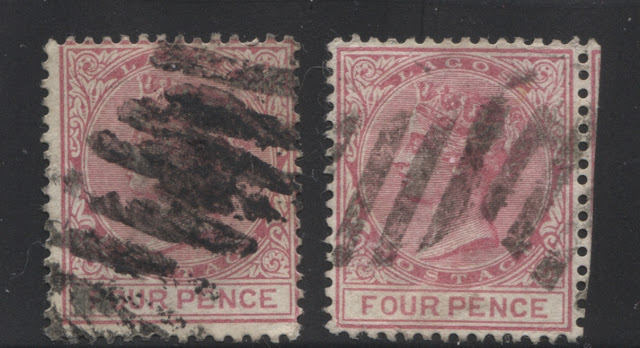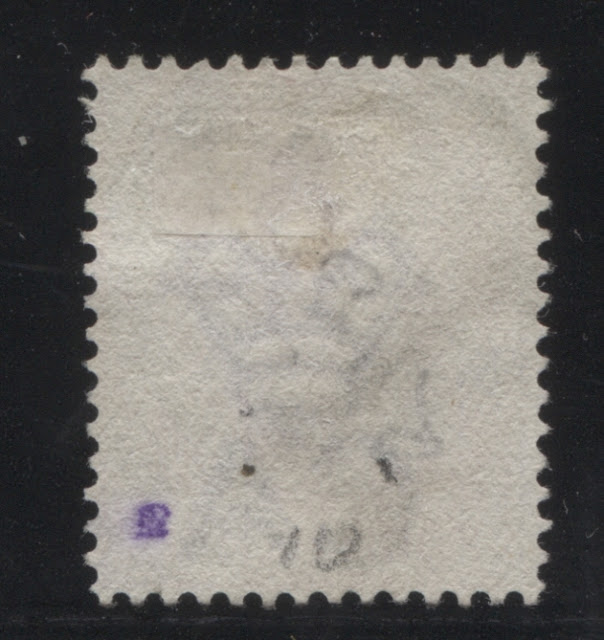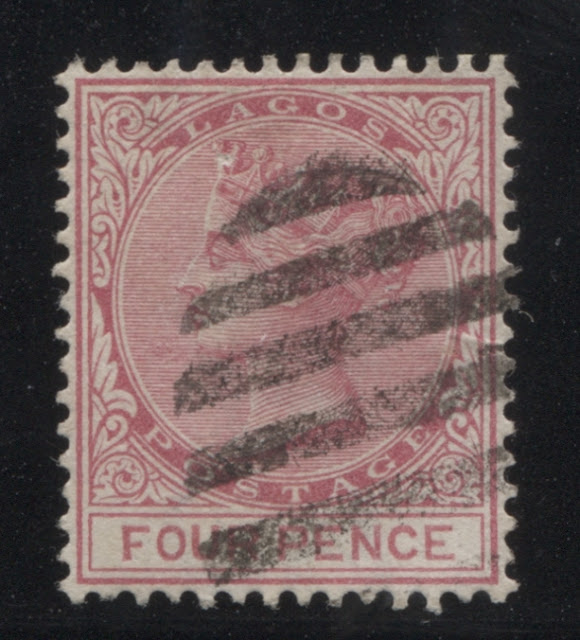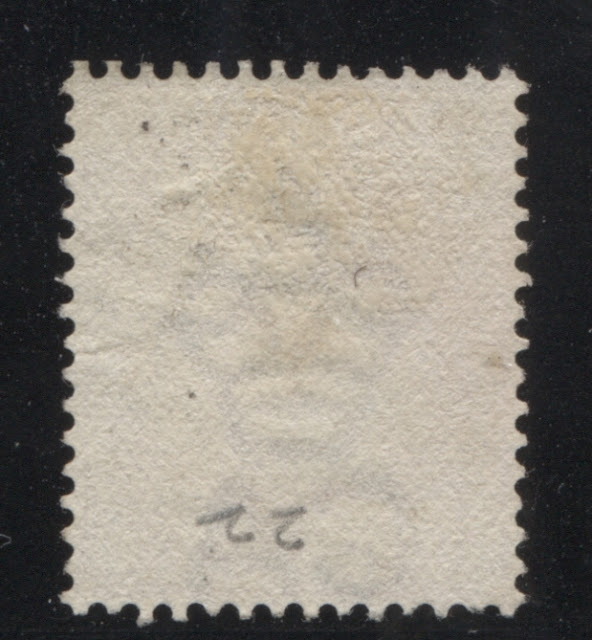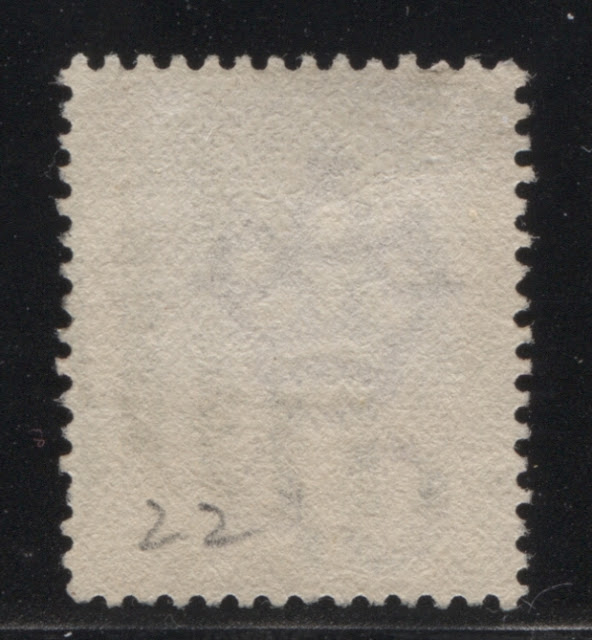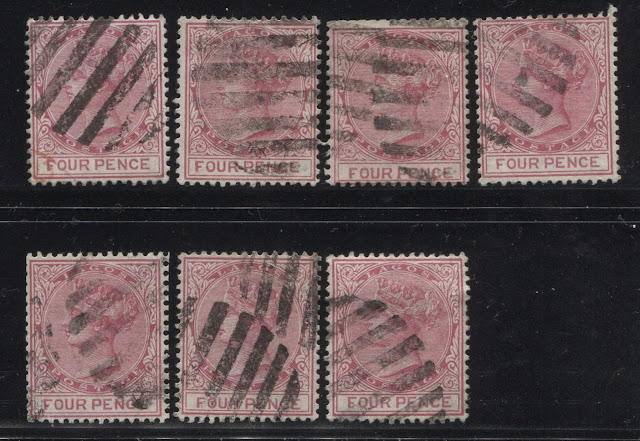Today's post will explore the last of the Queen Victorian issues to not comply with the colour requirements of the Universal Postal Union: the 4d rose, watermarked crown CA.
There were 36,240 stamps printed, making it the largest quantity of stamps out of the 1d, 2d, 3d and 4d values. Yet, mint stamps are extremely scarce, with the vast majority of the examples you will encounter being used. The very first shipment was sent out to the colony on February 14, 1882, and the last was sent on April 28, 1884. Thus there was a period of just over 26 months during which this stamp was current. Given that the Crown Agents supplied stamps on a quarterly basis, and the basic inland postage rate was 2d, this would have seen heavy usage, and therefore, it is reasonable to expect that there should have been 8 or 9 printings.
However, in my examination of the five mint and 37 used examples of this stamp in my stock, I have identified 12 different shade combinations, Some of these are very close to one another, and it is likely that they are mere variations of the same printing. I will describe their characteristics here and then draw some preliminary conclusions about the approximate order of the printings.
The approximate dispatch dates for 9 printings would be as follows:
February 14, 1882
Early June 1882
September 1882
December 1882
April 1883
July 1883
October 1883
January 1884
April 28, 1884
The gum will not be much help here because it was crackly throughout the period while these stamps were current. Most cancellations will be the 8-bar oval killers, though where a printing seems to have been cancelled mostly by the 9-bar type, we can attribute these to later dates in the series, like 1884.
The shade on this stamp shows quite a lot of variation, though at first glance they may appear quite similar. The darkest shades are a definite rose-carmine, with a bluish undertone in which the carmine dominates. In this shade, we will see bright and dull versions, as well as pale versions. Then the carmine diminishes, and the rose begins to dominate, giving rise to carmine-rose shades. Again, these can be deep, dull, pale and bright. Finally, we have rose shades, in which there is no carmine at all. These are generally much paler than the other shades, and can be mistakenly identified as being faded, when in fact, they are different colours altogether. Generally speaking, I found that the duty plate (words "Four Pence") were printed in the same colour as the head plate. However in a couple of instances, there were some very slight differences, which are best seen with a loupe.
Most of the printings are on paper that shows a faint vertical mesh, with watermarks that show clearly without the aid of watermark fluid, but there are some on paper that does not show clear mesh, and for which the watermark is less visible. These would generally fall at the end of the period rather than the beginning or middle.
Group 1
Looking at the back, the stamps all show faint vertical mesh, and clearly visible watermarks, though the watermark on the left stamp is little faint. This again supports the notion that these are not the last printings, but probably a mid printing made sometime in 1883.
Group 2
Group 3
Group 4
Group 5
Clearly that third stamp from the left does not belong with this group, as the watermark is brightly visible, and there is very clear vertical mesh, whereas the other stamps show no clear mesh and only faint watermarks. Thus, it would seem like this is one of the last printings made in 1883 or 1884.
Group 6
Above are two mint stamps from this group, which is very similar to group 5, except that the rose is just a little bit deeper and brighter, lacking the milky quality. Again, both the head plate and duty plate are the same colour. Now let's take a look at the backs:
Group 7
Group 8
Group 9
Group 10
Group 11
Group 12
February 14, 1882
There were 36,240 stamps printed, making it the largest quantity of stamps out of the 1d, 2d, 3d and 4d values. Yet, mint stamps are extremely scarce, with the vast majority of the examples you will encounter being used. The very first shipment was sent out to the colony on February 14, 1882, and the last was sent on April 28, 1884. Thus there was a period of just over 26 months during which this stamp was current. Given that the Crown Agents supplied stamps on a quarterly basis, and the basic inland postage rate was 2d, this would have seen heavy usage, and therefore, it is reasonable to expect that there should have been 8 or 9 printings.
However, in my examination of the five mint and 37 used examples of this stamp in my stock, I have identified 12 different shade combinations, Some of these are very close to one another, and it is likely that they are mere variations of the same printing. I will describe their characteristics here and then draw some preliminary conclusions about the approximate order of the printings.
The approximate dispatch dates for 9 printings would be as follows:
February 14, 1882
Early June 1882
September 1882
December 1882
April 1883
July 1883
October 1883
January 1884
April 28, 1884
The gum will not be much help here because it was crackly throughout the period while these stamps were current. Most cancellations will be the 8-bar oval killers, though where a printing seems to have been cancelled mostly by the 9-bar type, we can attribute these to later dates in the series, like 1884.
The shade on this stamp shows quite a lot of variation, though at first glance they may appear quite similar. The darkest shades are a definite rose-carmine, with a bluish undertone in which the carmine dominates. In this shade, we will see bright and dull versions, as well as pale versions. Then the carmine diminishes, and the rose begins to dominate, giving rise to carmine-rose shades. Again, these can be deep, dull, pale and bright. Finally, we have rose shades, in which there is no carmine at all. These are generally much paler than the other shades, and can be mistakenly identified as being faded, when in fact, they are different colours altogether. Generally speaking, I found that the duty plate (words "Four Pence") were printed in the same colour as the head plate. However in a couple of instances, there were some very slight differences, which are best seen with a loupe.
Most of the printings are on paper that shows a faint vertical mesh, with watermarks that show clearly without the aid of watermark fluid, but there are some on paper that does not show clear mesh, and for which the watermark is less visible. These would generally fall at the end of the period rather than the beginning or middle.
Group 1
The above scan shows my sole mint example of a stamp from this group. The main characteristic of this group is that the shade of both the head plate, and the duty plate are a deep carmine-rose, with only a very slight hint of carmine.
The back of this stamp shows a smoother version of the gum, which though crackly, is very close in appearance to the gum found on the very first printings of the 2d slate and 4d mauve, from the next issue, which were made in 1884. Threfore, it would appear that this may be one of the later printings, or at least a mid-range printing from 1883. Let's take a look at some used examples and see what they can tell us:
Here are the three used stamps from this group as seen from the front. These all look like they have been cancelled with 8-bar oval killers, which tends to suggest that they are not likely to be from the very last printings, though a sample of 3 is very small, and it is difficult to be certain of that conclusion with just 3 stamps. Looking at the paper from the back may help provide some additional clues:
Looking at the back, the stamps all show faint vertical mesh, and clearly visible watermarks, though the watermark on the left stamp is little faint. This again supports the notion that these are not the last printings, but probably a mid printing made sometime in 1883.
Group 2
I do not have any mint examples of this group, and just two used stamps which I show above. The shade of these two stamps is a definite rose-carmine for the head plate, while the duty plate is more of a deep rose, lacking the carmine tone. It is difficult to be certain because only part of the cancellations are visible, but these look again, like 8-bar killers, suggesting that these are earlier printings. Let's take a look at the backs to see what they tell us:
The backs show clear mesh and visible watermarks, which support their classification as earlier or mid-range printings from either 1882 or 1883.
Group 3
I have one mint example from this group, shown above. Sadly, it has a hinge remainder on the back that has left a stain on the stamp. This group again has the same shade for both the head and duty plates, and it can best be described as a slightly milky rose-carmine. There is a definite bluish undertone, though it is not as strong as the stamps in groups 2 and 4. Let's take a look and see what the gum looks like:
This is very crackly gum, which tends to suggest that this could be an early printing. But the watermark is not very visible here, which suggests that it might actually be a later printing. We need to take a look at the paper without the gum, and the cancellations for more clues. Let's look first at the cancellations:
Here we have nine used examples. From what I can see, these all appear to be 8-bar killers, which supports the idea that they may be earlier printings. Now, let's take a look at the backs:
Here, both the mesh and the watermarks are much less obvious than in the earlier printings, which supports the notion that these are later printings. So on this basis my preliminary conclusion is that this printing comes late in 1883 or very early in 1884.
Group 4
I only have two used examples from this group. At first glance, the shade looks similar to group 3, but on closer inspection it is both deeper and brighter, lacking the milky quality. It is a definite carmine-rose. But there is still a bluish undertone. Both the head plate and duty plate are the same colour. It is difficult to tell for certain, but these appear to be 8-bar killers, from the width of the bars. So this would suggest that these are early to mid printings. Now let's take a look at the backs for additional clues:
The mesh is visible, but quite faint, and the watermarks are very faint. This suggests to me that these are the later part to the middle period, like the second half of 1883. These may well be a sub-group of the same printing as group 3.
Group 5
I have one mint example from group 5. It has been stained quite heavily from the acids in the gum. This shade is a pure rose that contains no carmine, and is a little on the milky side. Both the head plate and duty plate are the same colour. Let's take a look at the gum:
As you can see, the gum is not very crackly, but it is quite toned. The watermark is not really visible at all, which tends to suggest that this is a late printing. Let's take a look at some used examples for additional insights:
The third stamp from the left, as you can see is much paler than the other three. I placed it with this group because it appears to me as though it may be faded. However, it is possible that it is simply a printing in very pale dull rose. Again, these stamps all appear to be cancelled with 8-bar killers, so they could really be from anywhere in the range. The backs should help settle the question of when they were printed:
Clearly that third stamp from the left does not belong with this group, as the watermark is brightly visible, and there is very clear vertical mesh, whereas the other stamps show no clear mesh and only faint watermarks. Thus, it would seem like this is one of the last printings made in 1883 or 1884.
Group 6
Above are two mint stamps from this group, which is very similar to group 5, except that the rose is just a little bit deeper and brighter, lacking the milky quality. Again, both the head plate and duty plate are the same colour. Now let's take a look at the backs:
The gum on these is strange in the sense that it is smooth, and isn't usually like this on crown CA stamps before 1886. So it is possible that these might be re-gummed or the gum may be disturbed and may have dried to a smooth appearance. The watermarks are not clearly visible like group 5, which suggests that they are a later printing. Let's take a look at a used example and see if it gives us any additional clues:
Unfortunately, this example doesn't really shed much light, at least from the front, because the cancel is not clear, and I can't tell if it is an 8-bar or 9-bar killer. Maybe the back will give us more insight:
The back shows no clear mesh and a faint watermark. Therefore, I would conclude that this is a late printing from late 1883 or early 1884. I believe now that groups 5 and 6 are likely the same printing.
Group 7
I only have two used examples from this group. The colour is a deep, bright rose pink that is not milky, and contains no carmine whatsoever. Both of the above stamps are cancelled with 8-bar killers, which suggests that they could be from anytime between 1882 and 1884. Now, let's take a look at the backs:
Again, these stamps do not show clear vertical mesh, and the watermarks are quite faint, which suggests that they are later printings, again likely from 1883 or 1884.Group 8
I have only one stamp from this group, and it is very similar to group 7, except that the duty plate colour is slightly darker than the head plate colour. The cancel is clearly an 8-bar type, which suggests that it could be from any time between 1882 and 1884. Let's see what the back tells us:
The back, once again, shows no clear mesh and a faint watermark, which suggests that this is a later printing.
Group 9
The stamps of this group are quite similar to group 7, except that the rose colour is deeper. The head plate and duty plate colours are both the same. These all appear to be cancelled with 8-bar killers, so they could be from anywhere in the date range. Let's take a look at the backs:
Here we see faint vertical mesh and faint watermarks. They are quite similar to the stamps of group 7, and again, this group may simply be a sub-type of the same printing as group 7.
Group 10
I only have one example of this group. The shade again, is similar to group 9, but the rose colour is just touch lighter, but it is not as bright as group 7. Again, the head plate and duty plate are the same colour. The cancellation appears to be an 8-bar killer, which suggests that it could be from anytime between 1882 and 1884. Let's take a look at the back:
Here there is no visible mesh, and the watermark is barely visible, which again suggests that it is one of the later printings.
Group 11
This is a very distinct printing. The head plate shade is a deep, bright carmine-rose, while the duty plate is a dull carmine. The cancellation this time is definitely a 9-bar killer, as the bars are much narrower, and more closely spaced. This suggests that it is from the very last printing. Let's take a look at the back and see if it supports this notion:
Here the watermark is faint, but there is a very faint vertical mesh, which is not consistent with this being the last printing. I think this is quite possibly one the earlier printings that was used later in the period.
Group 12
The stamps of this group are very similar to group 9, but the rose is just a bit deeper with a small hint of carmine. The head plate and duty plate colours are very close, but I believe that the duty plate coour is more of a pure rose, without any carmine. These all appear to have been cancelled by 8-bar killers, which doesn't really help us much. Let's take a look at the backs:
These appear fairly similar to the group 9 stamps, with most stamps having faint mesh and faint to visible watermarks. On the basis of what I have seen, I would conclude that this group and the stamps of group 9 are one of the earlier printings from late 1882 or early 1883.
Preliminary Conclusions on the Assignment of Printings
It seems fairly clear to me after looking carefully at all the stamps that although I identified 12 different groups of stamps, there are really only 9 different printings, and that:
- Groups 3 and 4 are the same printing.
- Groups 5 and 6 are the same printing.
- Groups 9 and 12 are the same printing.
The cancellations were really of very little help since all the stamps except for the stamp from group 11 were cancelled with an 8-bar killer.
The papers were useful and revealed that:
Groups 1, 2, 4, 9, 11, and 12 showed some degree of vertical mesh.
Groups 3, 5, 6, 7, 8, and 10 showed no obvious vertical mesh and generally the watermarks are less clear.
If groups 3 and 4 are from the same printing, then it is a cross-over printing in which some of the paper used shows mesh and the bulk of which does not.
The dates that I postulate for the 9 printings again are:
February 14, 1882
Early June 1882
September 1882
December 1882
April 1883
July 1883
October 1883
January 1884
April 28, 1884
Logically, the cross-over printing will come before the other late printings of which I now believe there were four. Counting back four printings from the last one places this printing in April 1883.
In assigning the other printings to dates, I believe that the shades should logically follow some type of progression. The most carmine of the shades is group 2, followed by group 1, then groups 9 and 12, and finally group 11. Group 11 has the 9-bar killer cancel, which we know dates from a later period. It makes sense then to postulate that the first four printings be assigned as follows:
February 14, 1882 - group 2.
Early June 1882 - group 1.
September 1882 - groups 9 and 12.
December 1882 - group 11.
Looking at the last four printings, I believe the shade progresses from the deep bright rose shades to the bright rose, and finally to the milky rose. So the assignment of these last four printings would appear to be:
July 1883 - group 8
October 1883 - group 10
January 1884 - group 7
April 28, 1884 - groups 5 and 6.
I am comfortable attributing groups 5 and 6 to the April 28, 1884 printing, as three of my five mint examples come from this printing, and one would expect that most mint examples will have come from the last printings, whereas most used examples will have come from the earlier printings, which would have been largely used up for postage. In contrast, there are likely to have been some remainders of the last printing as supplies of the new 4d mauve were arriving in the colony to replace this stamp. It certainly is the case that the number of examples I have from these last 4 printings is relatively small: 12 stamps out of a total of 42 stamps.
This takes me to the end of my discussion of the first crown CA issues of Lagos. The next series of posts will look at the monocoloured second crown CA issue, which complied with UPU regulations. I am going to split this next issue into three parts, as two of the values issued, the 1/2d and 1d were issued right up until 1903, resulting in dozens of printings each, whereas the remaining values, being the 2d, 4d, 6d, 1/-, 2/6d, 5/- and 10/- were entirely replaced by the bicoloured issue by 1887. Thus I will start with the higher values first, and will then dedicate separate posts to the 1/2d and 1d stamps.
September 1882
December 1882
April 1883
July 1883
October 1883
January 1884
April 28, 1884
Logically, the cross-over printing will come before the other late printings of which I now believe there were four. Counting back four printings from the last one places this printing in April 1883.
In assigning the other printings to dates, I believe that the shades should logically follow some type of progression. The most carmine of the shades is group 2, followed by group 1, then groups 9 and 12, and finally group 11. Group 11 has the 9-bar killer cancel, which we know dates from a later period. It makes sense then to postulate that the first four printings be assigned as follows:
February 14, 1882 - group 2.
Early June 1882 - group 1.
September 1882 - groups 9 and 12.
December 1882 - group 11.
Looking at the last four printings, I believe the shade progresses from the deep bright rose shades to the bright rose, and finally to the milky rose. So the assignment of these last four printings would appear to be:
July 1883 - group 8
October 1883 - group 10
January 1884 - group 7
April 28, 1884 - groups 5 and 6.
I am comfortable attributing groups 5 and 6 to the April 28, 1884 printing, as three of my five mint examples come from this printing, and one would expect that most mint examples will have come from the last printings, whereas most used examples will have come from the earlier printings, which would have been largely used up for postage. In contrast, there are likely to have been some remainders of the last printing as supplies of the new 4d mauve were arriving in the colony to replace this stamp. It certainly is the case that the number of examples I have from these last 4 printings is relatively small: 12 stamps out of a total of 42 stamps.
This takes me to the end of my discussion of the first crown CA issues of Lagos. The next series of posts will look at the monocoloured second crown CA issue, which complied with UPU regulations. I am going to split this next issue into three parts, as two of the values issued, the 1/2d and 1d were issued right up until 1903, resulting in dozens of printings each, whereas the remaining values, being the 2d, 4d, 6d, 1/-, 2/6d, 5/- and 10/- were entirely replaced by the bicoloured issue by 1887. Thus I will start with the higher values first, and will then dedicate separate posts to the 1/2d and 1d stamps.


